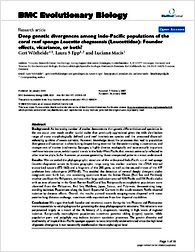Deep genetic divergences among Indo-Pacific populations of the coral reef sponge Leucetta chagosensis (Leucettidae): Founder effects, vicariance, or both?
Research article
Zeitschrift: BMC evolutionary biology, 20088, 24: 1 - 18
Wörheide, Gert; Epp, Laura S.; Macis, Luciana, 2008: Deep genetic divergences among Indo-Pacific populations of the coral reef sponge Leucetta chagosensis (Leucettidae): Founder effects, vicariance, or both? - Research article. In: BMC evolutionary biology; Vol. 8.2008, No. 24, p. 1-18, DOI: 10.23689/fidgeo-826.
 |
Dokument öffnen: |
Background: An increasing number of studies demonstrate that genetic differentiation and speciation in the sea occur over much smaller spatial scales than previously appreciated given the wide distribution range of many morphologically defined coral reef invertebrate species and the presumed dispersal-enhancing qualities of ocean currents. However, knowledge about the processes that lead to population divergence and speciation is often lacking despite being essential for the understanding, conservation, and management of marine biodiversity. Sponges, a highly diverse, ecologically and economically important reef-invertebrate taxon, exhibit spatial trends in the Indo-West Pacific that are not universally reflected in other marine phyla. So far, however, processes generating those unexpected patterns are not understood. Results: We unraveled the phylogeographic structure of the widespread Indo-Pacific coral reef sponge Leucetta chagosensis across its known geographic range using two nuclear markers: the rDNA internal transcribed spacers (ITS 1&2) and a fragment of the 28S gene, as well as the second intron of the ATP synthetase beta subunit-gene (ATPSb-iII). This enabled the detection of several deeply divergent clades congruent over both loci, one containing specimens from the Indian Ocean (Red Sea and Maldives), another one from the Philippines, and two other large and substructured NW Pacific and SW Pacific clades with an area of overlap in the Great Barrier Reef/Coral Sea... Conclusion: We argue that both founder and vicariance events during the late Pliocene and Pleistocene were responsible to varying degrees for generating the deep phylogeographic structure. This structure was perpetuated largely as a result of the life history of L. chagosensis, resulting in high levels of regional isolation. Reciprocally monophyletic populations constitute putative sibling (cryptic) species, while population para- and polyphyly may indicate incipient speciation processes. The genetic diversity and biodiversity of tropical Indo-Pacific sponges appears to be substantially underestimated since the high level of genetic divergence is not necessarily manifested at the morphological level.

